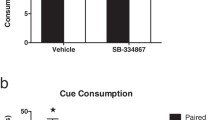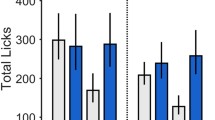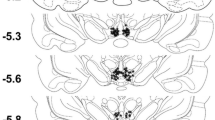Abstract
Rationale
The orexin/hypocretin system has recently been implicated in reward-seeking, especially for highly salient food and drug rewards. We reasoned that this system may be strongly engaged during periods of reward restriction, including food restriction.
Objectives
This study examined the involvement of the orexin (Orx) system in responding for sucrose, and in cue-induced reinstatement of extinguished sucrose-seeking, in ad libitum fed versus food-restricted male subjects.
Methods
Sprague–Dawley rats (n = 108) were trained to self-administer sucrose, and we determined the effects of pretreatment with the OxR1 receptor antagonist SB-334867 (SB; 10–30 mg/kg) on fixed ratio (FR) or progressive ratio (PR) sucrose self-administration, as well as on cue-induced reinstatement of sucrose-seeking. Finally, expression of the immediate early gene c-fos in Orx neurons was examined after self-administration, late extinction or cue-induced reinstatement of sucrose seeking.
Results
SB decreased lever responding (by about 1/3) and the number of reinforcers earned during FR, and less so during PR, schedules and decreased cue-induced reinstatement to sucrose-seeking to extinction levels, predominately in food-restricted rats. Additionally, Fos expression in Orx neurons in perifornical and dorsomedial hypothalamus was increased during extinction.
Conclusions
These results indicate that signaling at the OxR1 receptor is involved in pronounced sucrose reinforcement, and reinstatement of sucrose-seeking elicited by sucrose-paired cues, in food-restricted subjects. These findings lead us to conclude that conditioned activation of Orx neurons increases motivation for food reward during food restriction.





Similar content being viewed by others
References
Akanmu MA, Honda K (2005) Selective stimulation of orexin receptor type 2 promotes wakefulness in freely behaving rats. Brain Res 1048:138–145
Aston-Jones G, Smith RJ, Moorman DE, Richardson KA (2009) Role of lateral hypothalamic orexin neurons in reward processing and addiction. Neuropharm 56:112–121
Aston-Jones G, Smith RJ, Sartor GC, Moorman DE, Massi L, Tahsili-Fahadan P et al (2010) Lateral hypothalamic orexin/hypocretin neurons: a role in reward-seeking and addiction. Brain Res 1314:74–90
Avena NM, Rada P, Hoebel BG (2008) Underweight rats have enhanced dopamine release and blunted acetylcholine response in the nucleus accumbens while bingeing on sucrose. Neuroscience 156(4):865–871
Berridge KC (1991) Modulation of taste affect by hunger, caloric satiety, and sensory-specific satiety in the rat. Appetite 16(2):103–120
Borgland SL, Chang SJ, Bowers MS, Thompson JL, Vittoz N, Floresco SB et al (2009) Orexin A/Hypocretin-1 selectively promotes motivation for positive reinforcers. J Neurosci 29:11215–11225
Burdakov D, Luckman SM, Verkhratsky A (2005) Glucose-sensing neurons of the hypothalamus. Philos Trans R Soc Lond B Biol Sci 360:2227–2235
Cason AM, Smith RJ, Tahsili-Fahadan P, Moorman DE, Sartor GC, Aston-Jones G (2010) Role of orexin/hypocretin in reward-seeking and addiction: implications for obesity. Physiol Behav 100(5):419–428
Castellanos EH, Charboneau E, Dietrich MS, Park S, Bradley BP, Mogg K et al (2009) Obese adults have visual attention bias for food cue images: evidence for altered reward system function. Int J Obes 33:1063–1073
Choi DL, Davis JF, Fitzgerald ME, Benoit SC (2010) The role of orexin-A in food motivation, reward-based feeding behavior and food-induced neuronal activation in rats. Neuroscience 167(1):11–20
Choi DL, Davis JF, Magrisso IJ, Fitzgerald ME, Lipton JW, Benoit SC (2012) Orexin signaling in the paraventricular thalamic nucleus modulates mesolimbic dopamine and hedonic feeding in the rat. Neuroscience 210:243–248
Davis JD, Perez MC (1993) Food deprivation- and palatability-induced microstructural changes in ingestive behavior. Am J Physiol 264(1):R97–R103
de Lecea L, Kilduff TS, Peyron C, Gao X, Foye PE, Danielson PE et al (1998) The hypocretins: hypothalamus-specific peptides with neuroexcitatory activity. Proc Natl Acad Sci USA 95:322–327
Espana RA, Melchior JR, Roberts DC, Jones SR (2010) The hypocretin-orexin system regulated cocaine self-administration via actions on the mesolimbic dopamine system. Eur J Neurosci 31(2):336–348
Fadel J, Moore H, Sater M, Bruno JP (1996) Trans-synaptic stimulation of cortical acetylcholine release after partial 192 IgG-saporin-induced loss of cortical cholinergic afferents. J Neurosci 16(20):6592–6600
Floresco SB, McLaughlin RJ, Haluk DM (2008) Opposing roles for the nucleus accumbens core and shell in cue-induced reinstatement of food-seeking behavior. Behav Brain Res 190(1):85–96
Frederick-Duus D, Guyton MF, Fadel J (2007) Food-elicited increases in cortical acetylcholine release require orexin transmission. Neuroscience 149(3):499–507
Gonzalez JA, Jensen LT, Fugger L, Burdakov D (2008) Metabolism-independent sugar sensing in central orexin neurons. Diabetes 57:2569–2576
Harris G, Aston-Jones G (2006) Arousal and reward: a dichotomy in orexin function. Trends Neurosci 29:571–577
Harris GC, Wimmer M, Aston-Jones G (2005) A role for lateral hypothalamic orexin neurons in reward seeking. Nature 437:556–559
Huang XF, Yu Y, Zavitsanou K, Han M, Storlien L (2005) Differential expression of dopamine D2 and D4 receptor and tyrosine hydroxylase mRNA in mice prone, or resistant, to chronic high-fat diet-induced obesity. Brain Res Mol Brain Res 135(1–2):150–161
Inglis FM, Day JC, Fibiger HC (2004) Enhanced acetylcholine release in hippocampus and cortex during the anticipation and consumption of a palatable meal. Neuroscience 62(4):1049–1056
Ishii Y, Blundell JE, Halford JC, Upton N, Porter R, Johns A et al (2004) Differential effects of the selective orexin-1 receptor anagonist SB-334867 and lithium chloride on the behavioural satiety sequence in rats. Physiol Behav 81:129–140
Ishii Y, Blundell JE, Halford JC, Upton N, Porter R, Johns A et al (2005) Satiety enhancement by selective orexin-1 receptor anagonist SB-334867: influence of test context and profile comparison with CCK8-S. Behav Brain Res 160:11–24
Kelley AE, Bakshi VP, Fleming S, Holahan MR (2000) A pharmacological analysis of the substrates underlying conditioned feeding induced by repeated opioid stimulation of the nucleus accumbens. Neuropsychopharm 23(4):455–467
Kilduff TS, de Lecea L (2001) Mapping of the mRNAs for the hypocretin/orexin and melanin-concentrating hormone receptors: networks of overlapping peptide systems. J Comp Neurol 435:1–5
Kurose T, Ueta Y, Yamamoto Y, Serino R, Ozaki Y, Saito J, Nagata S, Yamashita H (2002) Effects of restricted feeding on the activity of hypothalamic Orexin (Ox)-A containing neurons and OX2 receptor mRNA level in the paraventricular nucleus of rats. Regul Pept 104(1–3):145–51
Lawrence CB, Snape AC, Baudoin FM, Luckman SM (2003) Acute central ghrelin and GH secretagogues induce feeding and activate brain appetite centers. Endocrinology 143(1):155–162
Lin L, Faraco J, Li R, Kadotani H, Rogers W, Lin X et al (1999) The sleep disorder canine narcolepsy is caused by a mutation in the hypocretin (orexin) receptor 2 gene. Cell 98:365–376
Lopez M, Seoane L, Garcia MC, Lago F, Casanueva FF, Senaris R et al (2000) Leptin regulation of prepro-orexin and orexin receptor mRNA levels in the hypothalamus. Biochem Biophys Res Commun 269:41–45
Lu XY, Bagnol D, Burke S, Akil H, Watson SJ (2000) Differential distribution and regulation of OX1 and OX2 orexin/hypocretin receptor messenger RNA in the brain upon fasting. Horm Behav 37:335–344
Lutter M, Krishnan V, Russo SJ, Jung S, McClung CA, Nestler EJ (2008) Orexin signaling mediates the antidepressant-like effect of calorie restriction. J Neurosci 28(12):3071–3075
Mahler SV, Smith RJ, Aston-Jones G (2012) Interactions between VTA orexin and glutamate in cue-induced reinstatement of cocaine seeking in rats. Psychopharmacology. doi:10.1007/s00213-012-2681-5
Marchant NJ, Hamlin AS, McNally GP (2009) Lateral hypothalamus is required for context-induced reinstatement of extinguished reward seeking. J Neurosci 29(5):1331–1342
Marcus JN, Aschkenasi CJ, Lee CE, Chemelli RM, Saper CB, Yanagisawa M et al (2001) Differential expression of orexin receptors 1 and 2 in the rat brain. J Comp Neurol 435:6–25
McLaughlin RJ, Floresco SB (2007) The role of different subregions of the basolateral amygdala in cue-induced reinstatement and extinction of food-seeking. Neuroscience 146(4):1484–1494
Millan EZ, Furlong TM, McNally GP (2011) Accumbens shell–hypothalamus interactions mediate extinction of alcohol seeking. J Neurosci 30(13):4626–4635
Moore H, Sarter M, Bruno JP (1993) Bidirectional modulation of stimulated cortical acetylcholine release by benzodiazepine receptor ligands. Brain Res 627(2):67–74
Nair SG, Golden SA, Shaham Y (2008) Differential effects of the hypocretin 1 receptor antagonist SB 334867 on high-fat food self-administration and reinstatement of food seeking in rats. Br J Pharmacol 154(2):406–416
Nijs IM, Muris P, Euser AS, Franken IH (2010) Differences in attention to food and food intake between overweight/obese and normal-weight females under conditions of hunger and satiety. Appetite 54(2):243–254
Pankevich DE, Teegarden SL, Hedin AD, Jensen CL, Bale TL (2010) Caloric restriction experience reprograms stress and orexigenic pathways and promotes binge eating. J Neurosci 30(48):16399–16407
Perello M, Sakata I, Birnbaum S, Chuang JC, Osborne-Lawrence S, Rovinsky SA et al. (2010) Ghrelin increases the rewarding value of high-fat diet in an orexin-dependent manner. Biol Psychiatry 67(9):880–886
Peters J, Kalivas PW, Quirk GJ (2009) Extinction circuits for fear and addiction overlap in the prefrontal cortex. Learn Mem 16(5):279–288
Petrovich GD, Setlow B, Holland PC, Gallagher M (2002) Amygdalo-hypothalamic circuit allows learned cues to override satiety and promote eating. J Neurosci 22:8748–8753
Peyron C, Tighe DK, van den Pol AN, de Lecea L, Heller HC, Sutcliffe JG et al (1998) Neurons containing hypocretin (orexin) project to multiple neuronal systems. J Neurosci 18:9996–10015
Rada P, Avena NM, Hoebel BG (2005) Daily bingeing on sugar repeatedly releases dopamine in the accumbens shell. Neuroscience 134(3):737–744
Richards JK, Simms JA, Steensland P, Taha SA, Borgland SL, Bonci A et al (2008) Inhibition of orexin-1/hypocretin-1 receptors inhibits yohimbine-induced reinstatement of ethanol and sucrose seeking in Long–Evans rats. Psychopharm 199:109–117
Richardson, Roberts (1996) Progressive ratio schedules in drug self-administration studies in rats: a method to evaluate reinforcing efficancy. J Neurosci Methods 66(1):1–11
Rodgers RJ, Halford JC, Nunes de Souza RL, Canto de Souza AL, Arch JR, Blundell JE (2000) Dose–response effects of orexin-A on food intake and the behavioural satiety sequence in rats. Regul Pept 96:71–84
Rodgers RJ, Halford JC, Nunes de Souza RL, Canto de Souza AL, Piper DC, Arch JR et al (2001) SB-334867, a selective orexin-1 receptor antagonist, enhances behavioural satiety and blocks the hyperphagic effect of orexin-A in rats. Eur J Neurosci 13:1444–1452
Rothemund Y, Preuschhof C, Bohner G, Bauknecht HC, Klingebiel R, Flor H et al (2007) Differential activation of the dorsal striatum by high-calorie visual food stimuli in obese individuals. Neuroimage 37(2):410–421
Sakurai T, Amemiya A, Ishii M, Matsuzaki I, Chemelli RM, Tanaka H et al (1998) Orexins and orexin receptors: a family of hypothalamic neuropeptides and G protein-coupled receptors that regulate feeding behavior. Cell 92:573–585
Scott MM, Marcus JN, Pettersen A, Birnbaum SG, Mochizuki T, Scammell TE et al (2011) Hcrtr1 and 2 signaling differentially regulates depression-like behaviors. Behav Brain Res 222(2):288–294
Sharf R, Sarhan M, Brayton CE, Guarnieri DJ, Taylor JR, DiLeone RJ (2010) Orexin signaling via the orexin 1 receptor mediates operant responding for food reinforcement. Biol Psychiatry 67(8):753–760
Smith RJ, Aston-Jones G (2012) Orexin/hypocretin 1 receptor antagonist reduces heroin self-administration and cue-induced heroin seeking. Eur J Neurosci 35(5):798–804
Smith R, See R, Aston-Jones G (2009) Orexin/hypocretin signaling at the OX1 receptor regulates cue-elicited cocaine-seeking. Eur J Neurosci 30:493–503
Smith RJ, Tahsili-Fahadan P, Aston-Jones G (2010) Orexin/hypocretin is necessary for context-driven cocaine-seeking. Neuropharmacology 58(1):179–184
Spangler R, Wittkowski KM, Goddard NL, Avena NM, Hoebel BG, Leibowitz SF (2004) Opiate-like effects of sugar on gene expression in reward areas of the brain. Brain Res Mol Brain Res 124(2):134–142
Stice E, Yokum S, Burger KS, Epstein LH, Small DM (2008) Youth at risk for obesity show greater activation of striatal and somatosensory regions to food. J Neurosci 31(12):4360–4366
Stratford TR, Kelley AE (1997) GABA in the nucleus accumbens shell participates in the central regulation of feeding behavior. J Neurosci 17(11):4434–4440
Stratford TR, Kelley AE (1999) Evidence of a functional relationship between the nucleus accumbens shell and lateral hypothalamus subserving the control of feeding behavior. J Neurosci 19(24):11040–11048
Sutcliffe JG, de Lecea L (2002) The hypocretins: setting the arousal threshold. Nat Rev Neurosci 3:339–349
Thorpe AJ, Cleary JP, Levine AS, Kotz CM (2005) Centrally administered orexin A increases motivation for sweet pellets in rats. Psychopharm 182(1):75–83
Trivedi P, Yu H, MacNeil DJ, Van der Ploeg LH, Guan XM (1998) Distribution of orexin receptor mRNA in the rat brain. FEBS Lett 438:71–75
Vialou V, Cui H, Perello M, Mahgoub M, Yu HG, Rush AJ et al (2011) A role for delta FosB in calorie restriction-induced metablic changes. Biol Psychiatry 70(2):204–207
White CL, Ishii Y, Mendoza T, Upton N, Stasi LP, Bray GA et al (2005) Effect of a selective OX1R antagonist on food intake and body weight in two strains of rats that differ in susceptibility to dietary-induced obesity. Peptides 26:2331–2338
Willie JT, Chemelli RM, Sinton CM, Tokita S, Wiliams SC, Kisanuki YY et al (2003) Distinct narcolepsy syndromes in Orexin receptor-2 and Orexin null mice: molecular genetic dissection of Non-REM and REM sleep regulatory processes. Neuron 38(5):715–730
Yamanaka A, Sakurai T, Katsumoto T, Yanagisawa M, Goto K (1999) Chronic intracerebroventricular administration of orexin-A to rats increases food intake in daytime, but has no effect on body weight. Brain Res 849:248–252
Zhang M, Kelley AE (2000) Enhanced intake of high-fat food following striatal mu-opioid stimulation: microinjection mapping and fos expression. Neuroscience 99(2):267–277
Zheng H, Patterson LM, Berthoud HR (2007) Orexin signaling in the ventral tegmental area is required for high-fat appetite induced by opioid stimulation of the nucleus accumbens. J Neurosci 27:11075–11082
Acknowledgements
This research was supported by the National institute of Drug Abuse grants F32 DA023354, R01 DA017289 and R37 DA06214.
Conflicts of interest
Dr. Aston-Jones has no biomedical financial interests or potential conflict of interests to disclose.
Author information
Authors and Affiliations
Corresponding author
Rights and permissions
About this article
Cite this article
Cason, A.M., Aston-Jones, G. Role of orexin/hypocretin in conditioned sucrose-seeking in rats. Psychopharmacology 226, 155–165 (2013). https://doi.org/10.1007/s00213-012-2902-y
Received:
Accepted:
Published:
Issue Date:
DOI: https://doi.org/10.1007/s00213-012-2902-y




